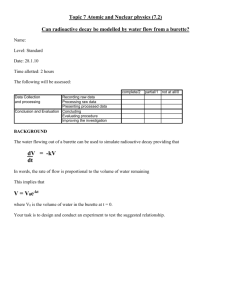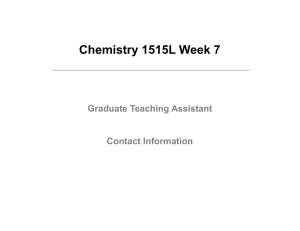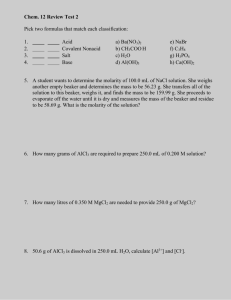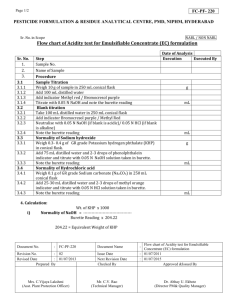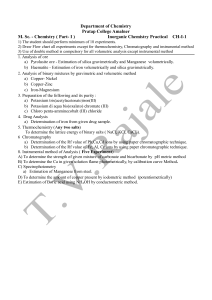Lab 3.4
advertisement
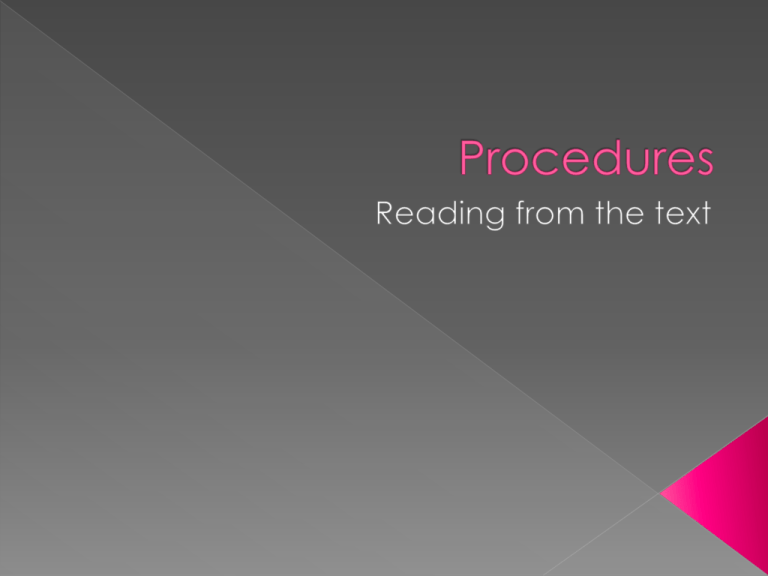
First, set up the clean, dry burette with a funnel on the top of it. Make sure that the burette is closed. Then, add the NaOH solution to the burette. Immediately clean up any spills of NaOH. Place a waste beaker below the burette and allow a small portion of the NaOH solution to run through the burette tip. Then, close the burette again. Then, using a clean, dry pipette, add 5.0 mL of the acid to a dilution flask. Fill the flask to a bit below the line, cap, and shake. Remove the cap and continue filling to the fill line. Using a new clean, dry pipette, add 25.0 mL of the diluted acid solution into a clean, dry Erlenmeyer flask. Add 2 or 3 drops of indicator to this flask. Then, place the flask underneath the burette tip. Write down the initial volume of NaOH in the burette. Carefully begin to add small portions of the NaOH solution from the burette, swirling the Erlenmeyer flask’s contents as you go. When the indicator begins to show a nonpermanent colour change, slow the addition of the NaOH and decrease how much is added each time. Continue adding until the colour change is permanent (when it lasts for 30 seconds or more). Record the ending volume of NaOH in the burette once this equivilence point has been reached. Repeat the titration process by adding 25.0 mL of the diluted acid to a new clean and dry Erlenmeyer and repeating the above. Repeat until you have 3 sets of titration data. Create a 1/20th dilution of the acid. Fill the burette with NaOH. Add 25 mL of the diluted acid to an Erlenmeyer flask. Add indicator. Titrate the diluted acid. Repeat the titration twice more. Clean up any spills of NaOH immediately. To … To determine the boiling point of a substance and if boiling point is a characteristic property If … then … because … If the class melting points are all the same, then … because … Liquids “A” and/or “B” 2 Test tubes Two hole rubber stopper Thermometer Glass bend Short rubber tubing Burner Ring stand Test tube clamps Beaker Boiling chips Water 1) Fill test tube 1/3 full of either liquid A or liquid B. 2) Add two boiling chips to the test tube. 3) Using glycerin to lubricate the thermometer and glass bend place the thermometer and glass bend in the two hole stopper. 4) Place the stopper with the glass bend and thermometer in the test tube and place this test tube over the burner. 5) Place the other (empty) test tube in the beaker containing cool water. 6) Attach the rubber tubing to the glass bend and place the free end of the rubber tubing in the empty test tube in the water. 7) Heat the test tube with the liquid in it, recording the temperature every 30 seconds until ¼ of the liquid remains. 8) Clean up your station. 9) Graph the time and temperature data. What would it look like? Time / minutes:seconds Temperature / degrees Celsius 0:00 23 0:30 24 1:00 25 1:30 27 2:00 29 2:30 32 3:00 36 Etc. Etc. 1) …? 2) …? 3) …? 2 graphs – what are they? 1) What are responsible for the different boiling points for substances A and B? 2) Based on your answer for the above, why would it make sense for boiling point to be a characteristic property (ie: why shouldn’t it depend on amount present)? 3) Suppose you had an unknown liquid. Propose at least two properties you could test that would allow you to determine the identity of the substance. Restate purpose Restate hypothesis 3 reasons for why your hypothesis was correct/incorrect Theme Scientist AND a brief summary of their work related to this lab/the theme
